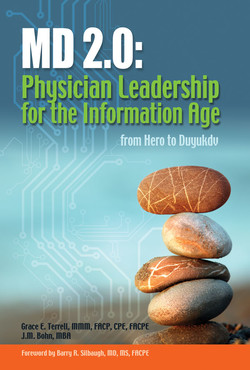Читать книгу MD 2.0: Physician Leadership for the Information Age - Grace Emerson Terrell MD - Страница 3
На сайте Литреса книга снята с продажи.
ОглавлениеPreface
MD 2.0: Physician Leadership for the Information Age is a new work focusing on the spectrum of issues faced by America’s current and future physician leaders. Contemporary physicians are confronting and embracing a vast array of challenges in today’s economic and regulatory climate. The acceleration of technological innovation and a renewed urgency for delivery system and financial reforms are generating new ideas and efforts to bring about dramatic change in the United States health care system.
In today’s global society, physicians carry varying degrees of power and influence in different parts of the world. The U.S. health care system is unique: considered the best in the world by some measure, and seriously flawed by other parameters. The physician community in America today is one that is highly regarded within the societal and political fabric of our country. Historically, this has not always been the case. Even today, various constraints are affecting the nature of physician power and influence. Physician Leadership in the Information Age provides some insights into the journey historically for the physician profession leading to the current state and analyzes the factors affecting the development of leaders among the physician community within various sectors of the health care industry. A transformation is underway with physician leadership in the twenty-first century from a heroic model that has been in place for centuries to one based upon collaboration, evidence-based actions, integrative care models, and information technology, and, most importantly, one having a sense of professional identity that we term duyukdv, (pronounced du-yu-(yo)-dv) a term from the Cherokee language. Duyukdv means truth, dignity, and living one’s life the right way and balancing the rights of the individual with the good of the whole. Our application of this term is as a translational concept that embodies the necessary professional transformation that will be required to lead the rapidly evolving health care delivery system in population health management, and custodianship.
Throughout this book we have drawn upon industry thought leadership from the health care industry, as well as the academic disciplines of sociology, psychology, health care policy, and business management in order to synthesize concepts and positions to stimulate critical thinking and planning for the physician community and those stakeholders and constituents engaged with this community.
Goal of This Book
Recognizing the transition that is underway in the U.S. health care system, we have a number of goals with this book. Our first goal is to explain why doctors think the way they do, and how it is that the physician community got to this point. With the transformational health care changes that are unfolding, the American public needs its physicians to provide leadership bed upon a healthy relationship between the practice of medicine as a profession and those who are the main stakeholders in health care reform, patients. Our second goal is to bring to the forefront some of the key points of the sociological transition that have occurred and brought American health care and especially the medical profession to where it stands today. A third goal is to address some of the barriers (organizational, psychosocial, technical, and structural) physician leaders are currently encountering and how, through the education, development, and social transformation of tomorrow’s physicians, we can overcome these barriers. Finally, we seek to evaluate the impact of the cultural renaissance that is occurring due to the implementation of new technologies and health care payment models, particularly as they pertain to the resulting power shifts throughout the health care system for physician leaders.
At the conclusion of several chapters we provide a set of reflection points for future consideration regarding long-range planning on leadership development in hopes that they may assist individual physician communities with the evaluation of health policy implications as they pertain to leadership development. Additionally, three profiles of current physician leaders are presented to help us learn from those who are successfully meeting the challenges of our times.
Given all of the changes underway in the U.S. health care system, we believe that it is critically important for physicians to lead health care organizations if we are to be successful in providing the highest quality and most cost-effective care to the patients we serve.
